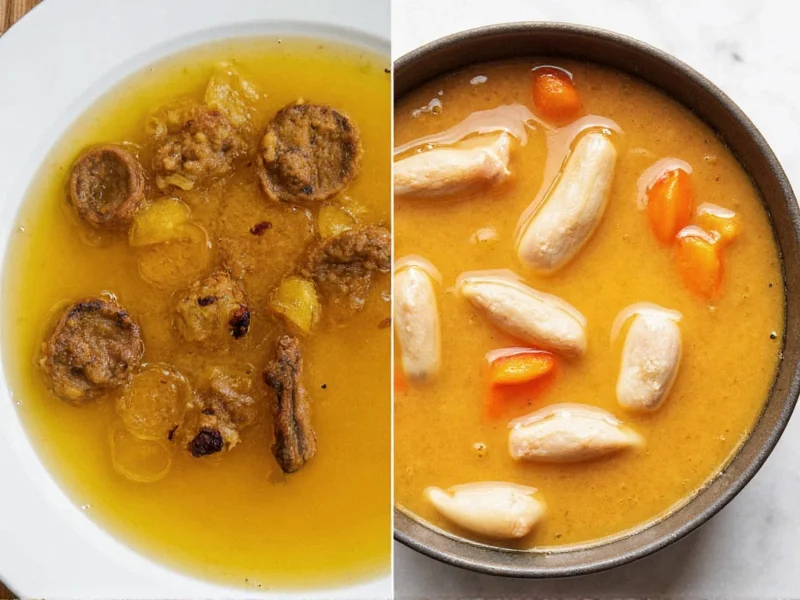Understanding the distinction between chicken stock and chicken broth transforms your cooking results. Many home chefs use these terms interchangeably, but professional kitchens treat them as separate ingredients with specific culinary purposes. The confusion stems from inconsistent labeling on store-bought products and overlapping usage in recipes. Knowing when to reach for stock versus broth elevates soups, sauces, and braises from ordinary to exceptional.
What Exactly Is Chicken Stock?
Chicken stock forms the backbone of professional cooking. Chefs create it by simmering chicken bones—often roasted first for deeper flavor—with vegetables, herbs, and water for 4-6 hours. The extended cooking time extracts collagen from bones and connective tissues, which converts to gelatin. This gives properly made stock its signature rich mouthfeel and ability to slightly coat the back of a spoon.
When cooled, quality chicken stock should gel due to the high gelatin content. It has a more neutral flavor profile compared to broth, making it ideal as a base that won't overpower other ingredients. The long simmering process creates a complex foundation that enhances dishes without dominating them.
Understanding Chicken Broth Characteristics
Chicken broth starts with more meat than bones—typically chicken pieces with meat still attached. Home cooks often use leftover roasted chicken carcasses with some meat remaining. The simmering time is shorter, usually 1-2 hours, which preserves the distinct chicken flavor while preventing the bitterness that can develop from overcooked bones.
Broth contains less gelatin than stock, resulting in a thinner consistency that doesn't gel when cooled. It delivers a more immediate, pronounced chicken taste that works well in finished dishes where you want the chicken flavor to shine through. Many commercial products labeled "broth" contain added salt and seasonings for direct consumption.
| Characteristic | Chicken Stock | Chicken Broth |
|---|---|---|
| Primary Ingredients | Bones (often roasted),少量 meat | Meat, some bones |
| Simmering Time | 4-6+ hours | 1-2 hours |
| Gelatin Content | High (gels when cooled) | Low (remains liquid) |
| Flavor Profile | Subtle, neutral base | Pronounced chicken taste |
| Sodium Level | Typically unsalted | Often contains added salt |
| Best Culinary Uses | Sauces, braises, risotto | Soups, stews, sipping |
When to Choose Stock Over Broth
Select chicken stock when you need a liquid that contributes body rather than dominant flavor. It works magic in pan sauces, where the gelatin helps emulsify fats and liquids into a cohesive, glossy finish. For risotto, stock's neutral profile allows the rice's starch to create creaminess without competing flavors. When making gravy, stock provides structure while absorbing the flavors of your drippings and seasonings.
Chef Thomas Keller emphasizes stock's role as "the canvas" in cooking—"a foundation that supports other elements without announcing itself." This makes stock indispensable for delicate dishes like poached fish or vegetable braises where you want liquid medium without strong chicken flavor.
Optimal Times for Chicken Broth
Reach for broth when the liquid itself should contribute noticeable flavor to the final dish. It shines in matzo ball soup, where the broth's chicken essence complements the dumplings. For quick weeknight soups with vegetables and noodles, broth delivers immediate flavor that doesn't require hours of development.
Broth works better than stock for sipping as a remedy when sick, thanks to its more pronounced flavor and typically higher sodium content (though you can always season stock to taste). When making casseroles or grain pilafs where the cooking liquid gets absorbed, broth imparts more distinct chicken flavor throughout the dish.
Homemade Stock and Broth Techniques
Creating both from scratch reveals their fundamental differences. For stock: roast 2-3 pounds of chicken bones at 400°F until golden, then cover with cold water along with 1 chopped onion, 2 carrots, 2 celery stalks, and herbs. Simmer gently for 5 hours, skimming impurities. Strain through cheesecloth for crystal-clear results.
For broth: place 3-4 pounds of chicken pieces (legs, thighs, or carcass with meat) in a pot with cold water, vegetables, and herbs. Bring to a gentle simmer and cook 90 minutes. The shorter time preserves the meat's flavor while extracting enough collagen for body without bitterness.
Addressing Common Misconceptions
Many believe "bone broth" is fundamentally different—it's actually just stock simmered longer (12-24 hours) to extract maximum collagen. Store-bought products often misuse these terms; check ingredients rather than relying on labels. Some "stocks" contain MSG or yeast extract to mimic gelatin's mouthfeel, while some "broths" have minimal meat content.
The notion that stock is always superior stems from professional kitchens where control over ingredients matters most. For home cooking with quality store-bought products, the distinction matters less—but understanding the difference helps you adapt recipes successfully.
Practical Substitution Guidance
When substituting stock for broth, boost flavor with additional seasonings since stock has milder taste. For broth in place of stock, add 1 teaspoon unflavored gelatin per cup to replicate stock's body in sauces. In most soups and stews, they're interchangeable with minor adjustments. Never substitute one for the other in recipes where texture is critical, like consommé or demi-glace.
Final Considerations for Culinary Success
Mastering the stock versus broth distinction empowers you to make informed decisions in the kitchen. While store-bought options have blurred these lines, understanding their fundamental differences helps you adapt recipes and achieve professional results. When following recipes, consider whether the liquid should provide structure (choose stock) or flavor (choose broth). For ultimate control, make your own—freezing portions in ice cube trays allows precise usage in future dishes. Remember that the best choice depends on your specific recipe's requirements rather than any inherent superiority of one over the other.











 浙公网安备
33010002000092号
浙公网安备
33010002000092号 浙B2-20120091-4
浙B2-20120091-4